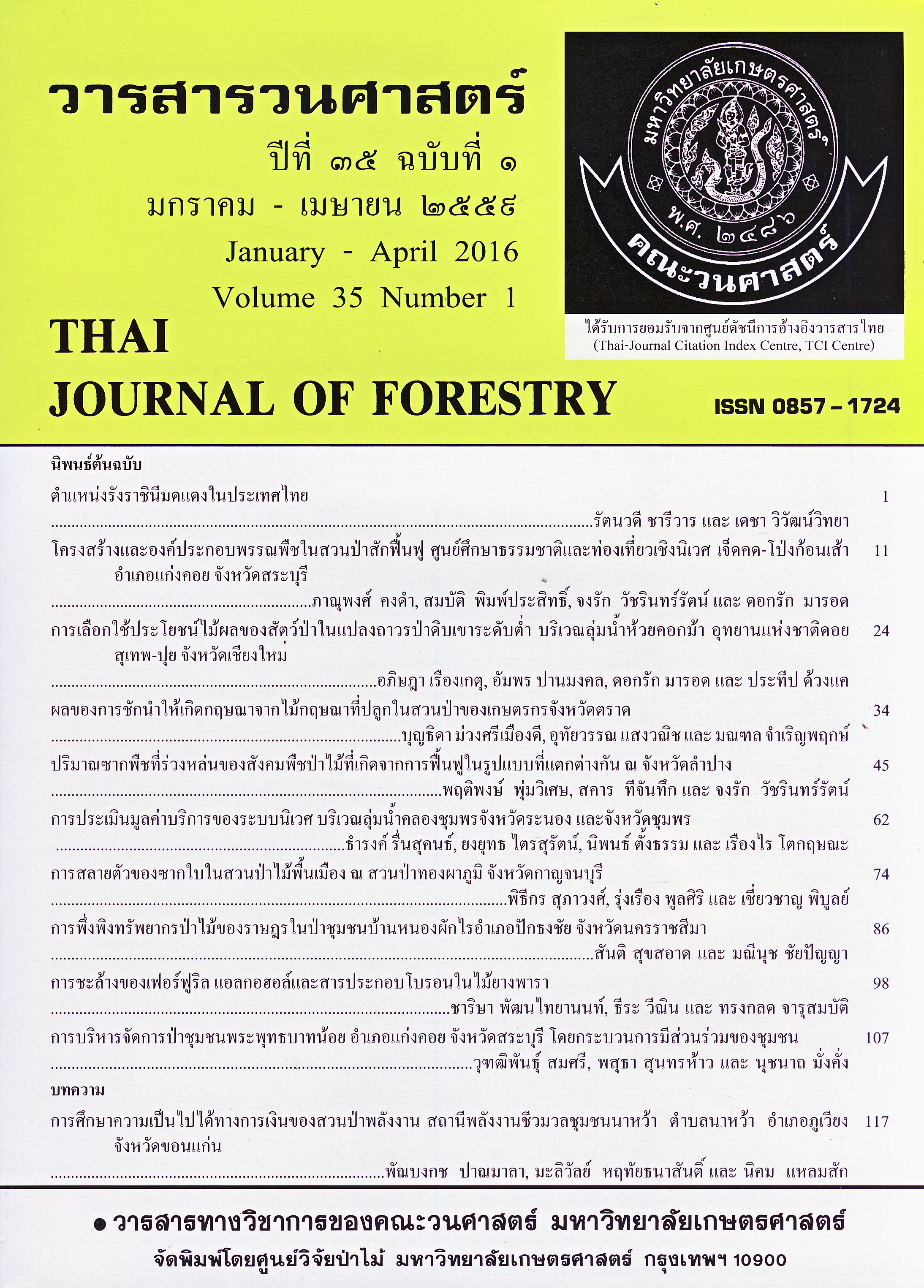ตำแหน่งรังราชินีมดแดงในประเทศไทย
Main Article Content
บทคัดย่อ
การศึกษาตำแหน่งรังราชินีมดแดงในประเทศไทยดำเนินการระหว่างปี พ.ศ. 2556 ถึง พ.ศ. 2557 เพื่อทราบ ขนาด ลักษณะโครงสร้าง ตำแหน่งและทิศทางของรังมดราชินี การหาตำแหน่งรังราชินีพิจารณาจากพฤติกรรมการปกป้องราชินีของมดงานเป็นหลัก นอกจากนี้ทำการนับจำนวนต้นไม้ที่มดแดงแต่ละโคโลนีครอบครอง จำนวนรังแยกตามขนาดรัง ลักษณะรัง วัดความสูงต้นไม้ ความสูงและความกว้างเรือนยอดต้นไม้ ความหนาแน่นและพฤติกรรมมดงานของแต่ละโคโลนีจากการศึกษาพบราชินีมดแดง 1 ตัวต่อโคโลนี ซึ่งอาศัยอยู่เฉพาะในรังขนาดเล็ก บนต้นไม้ต้นที่มีจำนวนรัง
มากที่สุด (ร้อยละ 93.5) และสูงที่สุด (ร้อยละ 93.75)ในกลุ่มต้นไม้ที่มดแดงแต่ละโคโลนีครอบครอง ภายในรังราชินีถูกแบ่งเป็น 1-3 ห้อง ทางเข้า-ออกของรังมีขนาดใหญ่กว่ารังอื่นๆ ตำแหน่งของรังราชินีส่วนใหญ่พบอยู่บริเวณส่วนกลางเรือนยอดแนวตั้ง (ร้อยละ 75 ของจำนวนรังราชินีทั้งหมด) และอยู่บริเวณช่วงกลางทรงพุ่มในแนวราบ (ร้อยละ 55ของจำนวนรังราชินีทั้งหมด) ความสัมพันธ์ระหว่างตำแหน่งรังราชินีกับความสูงของทรงพุ่มต้นไม้มีความสัมพันธ์กันอย่างมีนัยสำคัญยิ่งทางสถิติ (r = 0.648 ; P < 0.01) และความสัมพันธ์ระหว่างตำแหน่งรังราชินีมดแดงกับความกว้างของทรงพุ่มต้นไม้มีความสัมพันธ์กันอย่างมีนัยสำคัญทางสถิติ (r = 0.527 ; P < 0.05) รังของราชินีมดแดงพบได้ทุกทิศทางรอบต้นไม้ พบมากที่สุดทางทิศใต้ (ร้อยละ 24 ของจำนวนรังราชินีทั้งหมด) สำหรับทางเข้า-ออกของรังพบทางทิศตะวันตกเฉียงใต้มากที่สุด (ร้อยละ 24 ของจำนวนรังราชินีทั้งหมด)การศึกษานี้ช่วยแก้ปัญหาให้สามารถเลี้ยงมดแดงในพื้นที่ที่ไม่มีมดแดงอาศัย และเป็นรายงานใหม่ที่ยังไม่มีการศึกษามาก่อนในประเทศไทย
Downloads
Article Details
ข้าพเจ้าและผู้เขียนร่วม (ถ้ามี) ขอรับรองว่า ต้นฉบับที่เสนอมานี้ยังไม่เคยได้รับการตีพิมพ์และไม่ได้อยู่ในระหว่างกระบวนการพิจารณาตีพิมพ์ลงในวารสารหรือสิ่งตีพิมพ์อื่นใด ข้าพเจ้าและผู้เขียนร่วม (ถ้ามี) ยอมรับหลักเกณฑ์และเงื่อนไขการพิจารณาต้นฉบับ ทั้งยินยอมให้กองบรรณาธิการมีสิทธิ์พิจารณาและตรวจแก้ต้นฉบับได้ตามที่เห็นสมควร พร้อมนี้ขอมอบลิขสิทธิ์ผลงานที่ได้รับการตีพิมพ์ให้แก่วารสารวนศาสตร์ คณะวนศาสตร์ มหาวิทยาลัยเกษตรศาสตร์ กรณีมีการฟ้องร้องเรื่องการละเมิดลิขสิทธิ์เกี่ยวกับภาพ กราฟ ข้อความส่วนใดส่วนหนึ่ง หรือ ข้อคิดเห็นที่ปรากฏในผลงาน ให้เป็นความรับผิดชอบของข้าพเจ้าและผู้เขียนร่วม (ถ้ามี) แต่เพียงฝ่ายเดียว และหากข้าพเจ้าและผู้เขียนร่วม (ถ้ามี) ประสงค์ถอนบทความในระหว่างกระบวนการพิจารณาของทางวารสาร ข้าพเจ้าและผู้เขียนร่วม (ถ้ามี) ยินดีรับผิดชอบค่าใช้จ่ายทั้งหมดที่เกิดขึ้นในกระบวนการพิจารณาบทความนั้น”
เอกสารอ้างอิง
Hilkenbäumer, F. 1983. Schnitt der Obstgehöze.13. Auflage Verlag J.Neumann-Neudamm. Melsungen 144.
Hölldobler, B. and E. O.Wilson. 1990. The Ants. Belknap Press of Harvard UniversityPress, Cambridge, Massachusetts.
King Mongkut’s University of TechnologyThonburi,.King Mongkut’s Institute of Technology Ladkrabang Prince of Chumphon Campus and Rajamangala University of Technology Rattanakosin Wangkraikangwon Campus. 2012. The study evaluated the potential of its electricity from wind power in the west coast of the Gulf of Thailand to the south on the provinces. National Research Council of Thailand. (in thai)
Metzner, R. 1979. Das Schneiden der Obstbäume and Beerensträucher. 14. Auflage. Verlag Eugen Ulmer, Stuttgart.
Na Songkhla, P. 2012. The architectural style bush. Thankanpim Company Limited (1): 204 (in Thai)
National Science and Technology Development Agency (NSTDA). 2002. Wind Energy. Bangkok: 44. (in Thai)
Offenberg, J. and D. Wiwatwitaya. 2009.Conference on International Research on Food Security, Natural Resource Management and Rural Development. Weaver Ants Convert Pest Insects into Food-Prospects for the Rural Poor, October 6-8, 2009. University of Hamburg
Peng, R. and K. Christian. 2005. The control efficacy of the weaver ant, Oecophylla smaragdina (Hymenoptera: Formicidae), on the mango leafhopper, Idioscopus nitidulus (Hemiptera: Cicadellidea) in mango orchards in the Northern Territory. International fournol of pest Management 51(4): 297-304.
Puangmalee, J. and Suksard, S. 2014. Usevalue of non-timber forest products at khao khew community forest, hua khao sub district, doem bang nang buat district, suphan buri province. Thai J. For. 33 (1): 76-84 (in Thai)
Robinson, T. A., A. L. Lakso. And S. G. Carpenter. 1991. Canopy development, yield, and fruit quality of “Empire”and “Delicious” apple trees grown in four orchard production systems for ten years. J. Amer. Soc. Hort.Sci. 116 (2): 179-187.
Strauss. E. and R. Novak. 1998. Obstbau-Praxis. Österreichischer Agrarverlag,Klosterneuburg. 386. Varnishagul, G. 2003. Styling and pruning fruit trees. Kasetsart University (1):213 (in Thai)
Van Mele, P. and N. T. T. Cuc. 2000. Evolution and status of Oecophylla smaragdinaas a pest control agent in citrus in the Mekong Delta, Vietnam. International Journal of Pest Management 46: 295-301.
Van Mele, P. 2007. Improving your Tree Crops with Weaver ants. Africa Rice Center (WARDA). Ants as Friends. Cotonou, Benin and CABI, Egham, UK.
Van Mele, P. 2008. A historical review of research on the weaver ant Oecophylla in biological control. Agricultural and Forest Entomology 10:13-22.
Vanderplank, F. L. 1960. Oecophylla sp. And its relationship to the coconut bug. Psedotheraptus wayi Brown (Coreidae ) J. The bionomics andecology of the red free ant Anim. Ecol. 29: 15-33.
Van Itterbeeck, J., N. Sivongxay, B. Praxaysombath and A. V. Huis. 2014. Indigenous Knowledge of the edible weaver Ant Oecophylla smaragdina Fabricius Hymenoptera: Formicidae from theVientiane Plain, Lao PDR. Society of Ethnobiology 5: 4-12.
Varela, A. M. 1990. Work on the biology of Oecophylla longinoda. Annual Report 1989-90, NCDP. 71-82
Way, M. J. 1954. Studies on the life history and ecology of the ant Oecophyll longinoda Latreille. Bull. Entomol. Res. 45:93 -112.
Way, M. J. and K. C. Khoo, 1989. Relationship between Helopeltis theobromae damage and ants with special reference to Malaysian cocoa smallholdings. J.
Plant Prot. Trop. 6: 1-11.
Way, M. J. 1992. Role of ants in pest management. Rev.Entomal. 37: 479-503.
Wiwatwittaya, D. 2009. Life of weaver ant.Kasetsart University. (in Thai)


